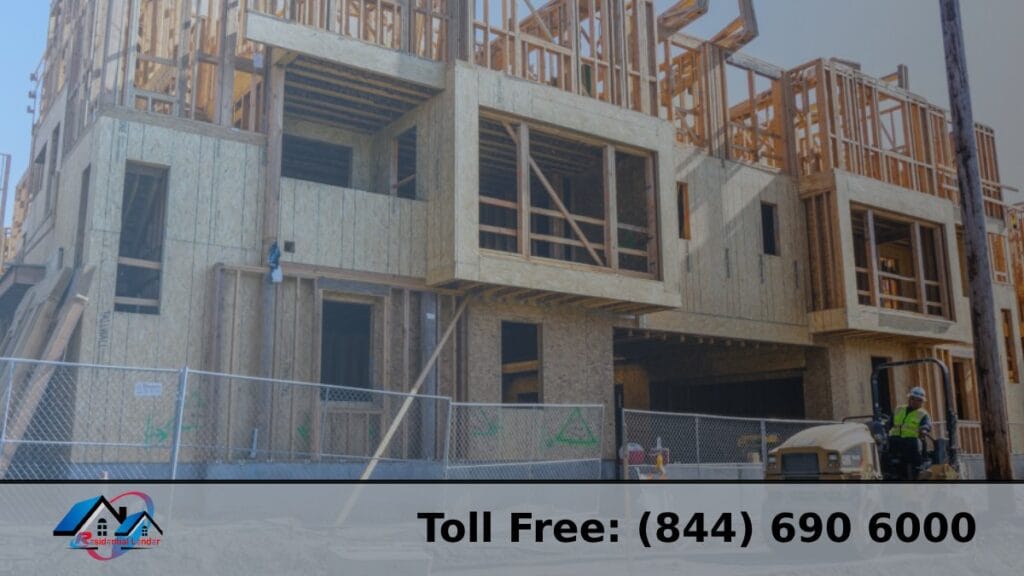New construction hard money loans are critical for real estate investors who want to build rental homes. These short-term loans are based on the value of the developed object instead of how well the borrower has paid back the loans. The process takes 12 to 24 months, but it is a faster and more open way to get money for construction projects.
These loans are rapidly available, adaptable, and simple to obtain, which makes them more appealing to property owners. Hard money lenders often don’t have as strict screening rules as banks do. Instead, they worry more about how well the project will work. This is very helpful for owners who might not have perfect credit or enough income to meet banks’ strict requirements, but have a good plan to build something and valuable collateral.
Conventional and hard money loans are not the same. Hard money loans focus more on the product’s value and the project’s chances. Investing in people who have trouble getting regular loans will be helpful. The interest rates on these loans are generally higher, though, and the terms for paying them back are shorter. Private lenders take on more risk because they put the item’s value before completing checks on the borrower.
Hard money loans for new construction are only good for a short time, so people who want to borrow money must have a clear plan to finish the job and repay the loan on time. Good project management and a clear exit plan are critical because construction delays can lead to higher interest rates and financial stress.
5 Steps to Apply for New Construction Hard Money Loans
Step 1: Research and Identify the Right Money Lender
You must research a reliable, experienced hard money lender specializing in new construction loans. This is the first and most important thing you need to do. Finding private lenders or lending companies with experience backing new construction projects like yours is significant. Do study before getting a hard money loan, as you should before any other financial deal. You need to learn a lot because not all lenders are the same or offer the same terms.
Finding a lender with a good reputation and experience with new construction is essential. Lenders who know a lot about how new construction projects work can better deal with the problems and time frames that come with them. Their knowledge can help you spot problems and come up with unique answers. This means that the requirements and process for getting funding are often more straightforward and better suited to the complicated nature of starting from scratch.
It is also essential to compare the loan terms and interest rates different lenders offer as part of the study. There are significant differences between lenders when it comes to hard money loans. In general, the interest rates are higher than on standard loans. Many investors pay close attention to the interest rates and any fees that come with them, such as transaction fees, closing costs, and possible fines for paying off the loan early. To know whether the project can be funded, you need to know how much it will cost to borrow.
Also, it’s essential to fully understand the loan-to-value (LTV) number given by the provider. The LTV ratio tells you how much of the property’s ATV (after-repair value) the loan is willing to pay. Most hard money lenders offer around 60% to 75% LTV for new construction projects. The user needs to get capital or loans from other people to cover the rest of the project’s costs. Some lenders use the LTV ratio to decide how risky a loan is. Borrowers need to know this ratio to understand how much money they can expect to get.
| Feature | Hard Money Loan | Traditional Loan | Conventional Loan |
| Approval Speed | Faster (days to weeks) | Slower (weeks to months) | Slower (weeks to months) |
| Qualification Criteria | The property’s potential and quick funding | Borrower creditworthiness and financial history | Borrower creditworthiness and financial history |
| Interest Rates | Typically higher | Generally lower | Generally lower |
| Loan Term | Shorter (6 months to 3 years) | Longer (15 to 30 years) | Longer (15 to 30 years) |
| Flexibility | More flexible terms and negotiations are possible | Less flexible, standardized terms | Less flexible, standardized terms |
| Emphasis | Property’s potential and quick funding | Borrower’s long-term financial stability | Borrower’s long-term financial stability |
Step 2: Prepare Your Project Details and Documentation
The next important step is to work hard to get all the paperwork and project details together after finding a possible lender. This means making a detailed construction plan and setting a reasonable due date for the job. You need a timeline and a thorough budget that lists all the costs you expect, like materials, labor, permits, and a fund in case something goes wrong. A well-organized and correct budget shows the investor that the borrower knows how much money the project will need. It also increases the chances of getting a loan. It might lead to better terms because it shows the borrower is less dangerous.
People who want to borrow money should be ready to bring all the legal and financial papers they need, along with the budget and building plan. Often, this includes formal documents that have to do with the property, such as the land purchase agreement and the property deed. When the project starts, you must also show that you have the money for the down payment and other costs. This can be done by showing old tax returns and recent bank records that show the money is available. Having these papers ready for the lender can speed up the application process and show that you are well-organized.
Suppose a real estate investor has worked on building or business projects before. In that case, they should say so on their loan application. One thing that can help the lender decide is a good project resume that lists past successes and shows a history of successful projects. Lenders are often more willing to lend money to people who have done it before. This is because they know how to run a new construction project well. The investor might believe you more, leading to better loan terms.
Finally, making a clear plan for how to get out of the loan is an essential part of getting ready. You must create a detailed plan to repay the loan by the due date. Out of a real estate deal, people often sell the finished property on the open market, refinance the hard money loan with a regular mortgage with a longer term, or find another long-term way to get the money. You must have a well-thought-out and realistic exit plan to get a loan. This shows the investor that you have a good plan to pay back the loan.
Step 3: Understand the Application Process and Lender Criteria
Once you have all the necessary information and paperwork, you should send an official loan request to the lender of your choice. This plan should include a complete account of the new construction project and a list of all the money that will be needed. The request for a loan is the first step in the application process. It needs to be clear, to the point, and convincing about how the borrower and the project can meet their goals.
When the investor gets the loan request, they will look into it. This usually means carefully reviewing the building plans, budget, and financial records. The lender will also get an appraisal of the property to determine how much the land is worth now and how much the building will be worth after it has been fixed. The lender will review the details and decide whether to give the cash. But if they do, they will be very clear about the rules. You can get a hard money loan faster than a standard loan. It doesn’t take weeks, just days. One of the best things about this type of lending for home buyers is the shorter time frame.
Hard money lenders look at a few important things when a new construction loan application comes in. The most important thing is the property’s value, as it is now, and what it will be worth when it is finished (ARV). Lenders want to know that the house will be worth enough when it’s done to pay back the loan plus interest and any other costs that might come up during the sale. It’s also essential to think about whether the building job is possible. It is vital for lenders to carefully review the building plans, budget, and schedule to see how likely it is that the project will be completed smoothly and on time.
Another critical factor is how much experience the borrower has as an investor or creator in real estate. Lenders are more likely to trust a borrower to finish a job if they have completed similar projects in the past that went well.
Hard money lenders are primarily interested in the product and how well the project will work. The borrower’s credit score is less important than tin raditional loans. However, it can still change the admission process. A good credit score can help first-time buyers give the lender more peace of mind. However, the loan choice is based on how much the collateral is worth and whether the building project can be completed. Why are hard money loans different? Because it focuses on assets. Because of this, it’s a good choice for investors whose past credit might not allow them to get regular loans.
Step 4: Review Loan Terms and Secure Funding
Once approved, you must read the loan deal carefully and fully understand its terms. This means paying close attention to the interest rates, which are usually higher for hard money loans, to make up for the lender’s higher risk and the short-term nature of the loan. Also, borrowers should know about all the fees that come with the loan, like origination fees, underwriting fees, closing costs, and any fines that might happen if they pay it off early. Another essential thing to know is how the loan will be paid back. For hard money loans, interest-only payments are standard during the building phase, and the entire loan amount is due at the end of the loan term.
The rules for a hard money loan might not be as strict as those for a regular loan, but the client might still be able to change some parts of the deal. This is especially true for borrowers with a good track record, a strong project plan, and a good idea of how much money they need. Successfully negotiating good terms can lead to a more customized financial plan that fits the needs and schedule of the new construction project more closely.
It is also essential to fully understand when the building funds will be drawn. Hard money lenders usually give out loan funds in stages or draws based on when certain building milestones are met. People taking out a loan should read their loan deal carefully and understand the critical dates and amounts that will be paid at each stage. Also, knowing the steps needed for review before each draw is made public is essential. Before making the next payment, lenders usually send an inspector to ensure the work is done according to the agreed-upon plans and budget.
Once the borrower is happy with all the loan terms and conditions, the last step in this stage is to make the deal official and secure the hard money loan. This means signing all the necessary papers and meeting any other lender standards. After these steps are done, the borrower will have gotten the funding and be able to start their new construction project.
Step 5: Manage the Loan and Construction Effectively
When using hard money to build a new home, keeping track of the loan and building process is essential. Staying clear and in constant touch with the moneylender is necessary during construction. As the construction goes on, let the lender know about any possible delays and how well the budget is being followed. This will help clear any confusion and ensure the money is sent out quickly and on time. Proactive contact between the borrower and the lender allows them to work together clearly and honestly. This can be very helpful if problems during the job are unplanned.
Sticking to the agreed-upon budget and building plan is also very important. If costs go up or the building schedule is pushed back, it can be challenging for the borrower to repay the loan in the short time allowed by most hard money deals. To stay on track and ensure the investment will pay off, the project must be well managed, and costs must be closely watched.
Hard money loans come with risks that people who want to borrow money should be aware of. These risks include higher interest rates that can make the project more expensive, shorter payback terms that mean the property has to be sold or refinanced quickly, and the chance that the bank will return the property if the project fails. That’s why it’s wise to save money in case of unexpected costs and develop a good marketing plan to sell or rent the house quickly when it’s done.
The last thing that needs to be done is to monitor the real estate market to ensure that the new construction project meets people’s needs and that the property can be sold or refinanced within the loan’s term. Market factors significantly impact how much a house is worth and how easy it is to rent or sell it. That’s why market research is an integral part of managing a hard-money new construction job all the time.
| Factor | Description | Importance |
| Experience in New Construction | Lender’s history of funding similar projects. | Ensures understanding of new construction’s unique challenges and timelines, which often leads to smoother processes. |
| Reputation and Reviews | Lender’s standing in the industry and feedback from previous borrowers. | Indicates reliability, trustworthiness, and the likelihood of a positive borrowing experience. |
| Interest Rates and Fees | The cost of borrowing, including the annual percentage rate and any upfront or ongoing charges. | This directly impacts the project’s profitability; it is crucial to compare multiple lenders to find the most competitive rates and fees. |
| Loan Terms (Duration, Repayment Structure) | The length of the loan and how payments are structured (e.g., interest-only, balloon payment). | It must align with the project’s timeline and the borrower’s exit strategy; short-term needs require a quick turnaround. |
| LTV Ratio | The lender will finance the percentage of the property’s after-repair value (ARV). | Determines the amount of financing available and the borrower’s required equity; lower LTVs typically indicate less risk for the lender. |
| Draw Process | The schedule and requirements for the lender to release funds as construction progresses. | Ensures funds are available for construction milestones; understanding the inspection process is crucial for avoiding delays. |
| Customer Support and Communication | The lender’s responsiveness, transparency, and willingness to address questions and concerns. | It facilitates a smoother borrowing experience and can be critical for resolving any issues that may arise during construction. |
Conclusion
There is a set way to get new construction hard money loans that you must follow. It’s essential to do a lot of research to find a money lender with experience in new construction, put together a lot of detailed project information and paperwork, learn how to apply for the loan and what the lender’s requirements are, carefully read over the loan terms, get the money you need, and then manage the loan and the construction project well until it’s done.
Real estate investors who can’t get traditional loans or need to act quickly on deals that close quickly can use hard money loans to pay for new projects. They are quick, flexible, and easy to use. Lenders shouldn’t just look at how creditworthy the borrower is; they should also look at how much the asset is worth and how much promise the project has. This could mean more chances to invest in the changing real estate market.
But you can only get hard money loans if you study, plan carefully, and run your business well. Investors need to be very picky about which lenders they work with, ensure they fully understand the risks and terms of the loan, and have a clear plan for how they will finish the project and pay back the loan quickly. Real estate investors can use new construction hard money loans when there are good development opportunities. However, they must carefully plan the process and know what the real estate market is doing now.
FAQs
What types of properties qualify for new construction hard money loans?
These loans are usually used for single-family homes, multi-family properties, and mixed-use projects that are supposed to be investments, not homes that people live in. The most important thing about the project is its possible after-repair value (ARV).
How are the funds from a new construction hard money loan disbursed?
On the other hand, hard money loans are often given out in stages, which are also known as draws. Specific building goals in the loan deal must be met to get these draws. They are often checked out before being let go.
What is the typical loan-to-cost (LTC) ratio for new construction hard money loans?
There are different loan-to-cost rates for these loans. Still, they usually pay for 75% to 90% of the whole project, which includes building the house and buying land. Lenders will also look at the loan-to-value (LTV) number based on the ARV.
Do I need experience as a real estate investor to qualify for a hard money loan for new construction?
Hard money lenders care more about how much the item is worth, but it can help to have built things or invested in real estate before. Lenders want to see that you understand the steps well and have a good chance of finishing the job.
What are the potential challenges or risks associated with new construction hard money loans?
High interest rates, shorter payback terms, the need for a clear exit plan, and the chance of failure if the project takes too long or costs too much are some of the problems that could happen. Having a fair budget and plan for lowering these risks is essential.








